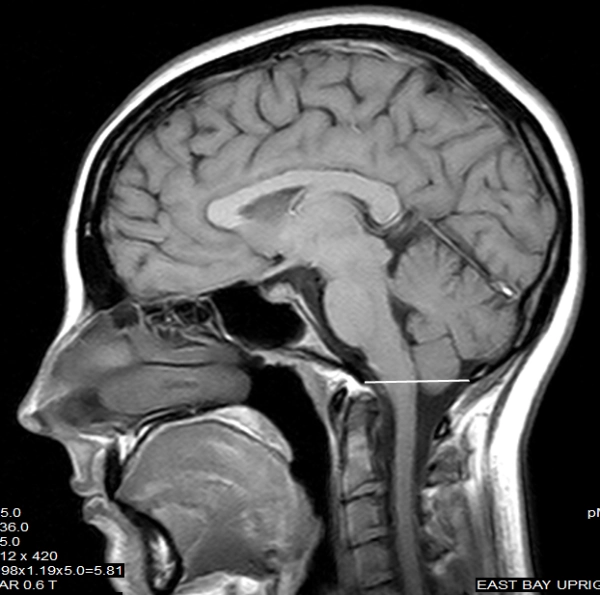
Could a headache be a brain herniation?
I originally wrote this article for Lifelines, the school paper at Life Chiropractic College West, in 2010. The original audience was, therefore, my classmates – future chiropractors. I realize that many of you reading this blog are not chiropractors, but I still think the information is valuable for any individual to recognize the possibility of this condition in themselves or a friend. This information is not intended to diagnose or treat anyone, and you should always seek the attention of a licensed healthcare professional – preferably (if this clinical picture sounds relevant to you) a chiropractor who has experience with this condition. Further, I am happy to answer any questions by email at [email protected]. – Satya Sardonicus, DC, CACCP
As chiropractors, our patients will often come in to the office with neck pain and a history of motor vehicle accident with associated whiplash – recent or past. In most cases, management of these individuals will be fairly simple. But there is an increasingly recognized condition that may occur following whiplash injury of which we should be aware. Cerebellar Tonsillar Ectopia (abbreviated CTE and also known as a Type I Arnold Chiari malformation when the ectopia is 5mm or more), is a herniation of the cerebellar tonsils through the foramen magnum. It can be congenital or acquired (commonly post-traumatic). The congenital form may be asymptomatic but become symptomatic following trauma – even minor trauma. Onset of symptoms usually occurs between age 25-454. CTE is found in about 5% of the population with no history of trauma, and almost 25% of people who’ve gotten whiplash(1).

The white line drawn in signifies the foramen magnum - the inferior border of the skull; the cerebellar tonsil should sit several millimeters above this line.
I share this information with you all as I have recently been diagnosed with a 6 mm CTE. I started having symptoms of muscle weakness and headache about 10 years ago, with increasing frequency and severity (as well as more symptoms) since then. It has been particularly difficult in the past several years, and several other diagnoses have been considered before we recognized the etiology of my clinical presentation. So I want to share with all of you a bit about the condition such that you might recognize and diagnose earlier your own patient who may have the same situation.
Symptoms of CTE have to do with cerebellar and brainstem compression, compromise of cerebrospinal fluid flow and increased intracranial pressure. They include persistent headache, neck pain, paresthesia, muscle weakness, ataxia, downbeat nystagmus, short term memory loss, dizziness, breathing difficulty, cardiac irregularities, dysphagia, tinnitus and other inner ear conditions, progressive spasticity including fibrillations and fasciculations. The headache is similar to a tension headache, may be described as circumferential compression and/or suboccipital deep tension. I have also experienced stabbing headaches all around my head (most often periorbitally) which feel like a fork being twisted in my skull, with increasing frequency and severity over time. Photopsia (the presence of perceived flashes of light) may also be present and should not be confused with the prodrome of classic migraine headaches. Absence of the gag reflex is the most common physical indicator of lower cranial nerve involvement. Extreme fatigue may be present and related to sleep apnea associated with this condition(4). Cerebellar Tonsillar Ectopia can present with a wide range of symptoms, and should be included in differential diagnosis with fibromyalgia, migraine headache, Lyme disease, multiple sclerosis and other similar conditions.
Treatment published in the literature is largely neurosurgical, where the most common surgeries are 1) remove part of the back of the occiput and laminectomy of C1, C2 and maybe C3, or 2) cut of the part of the brain which is herniated. The purpose is to restore CSF flow and decompress the area, preventing the development of a syrinx in the spinal cord. Non-surgical treatment is largely pharmacological and prescribed to alleviate the neuropathic pain (allodynia and hyperalgesia); drugs may include anticonvulsants and opiates, and there is little evidence for their efficacy with this type of pain4. Fernandez et al report some improvement with cerebellar re-education therapies, speech therapy, physical therapies for musculoskeletal function, and even osteopathic craniosacral therapy. They report craniosacral therapy to improve CSF flow and lower intracranial pressure. Personally I have been getting craniosacral therapy almost daily, as well as very light force upper cervical adjustments (similar to adjustment of an infant). It has been about 4 weeks, and it helps some…in the beginning I felt better for an hour or so and now adjustments are holding about 24 hours. I have been advised to give it 6 months of intensive work to see maximal change. As someone who has never had so much as a Tylenol in her life, I am extremely hesitant to undergo neurosurgery. I urge you to work with anyone with this condition conservatively first, with baby adjustments and craniosacral therapy. And write up case studies! The literature is sparse on any treatment other than surgery for this condition, and as chiropractors we may be able to help. I certainly look forward to the coming months, where I hope to find resolution to this condition through chiropractic care.
I want to urge you all to keep this condition in mind when you have a complicated patient, particularly if they are not improving significantly under your care. I have been under chiropractic care since birth, and so I knew there was something affecting my health other than subluxation. If your patients do not respond as you expect, this may be something to consider.
Freeman et al point out that these chronic symptoms “may not be ascribable to psychosocial factors…but rather to organic neurological injury(1).” With incidence rates of 25% in whiplash injury cases, we need to pay attention to the possibility of CTE in our patients. Further, these symptoms can look like fibromyalgia, multiple sclerosis, Lyme disease and other chronic illnesses. Upright MRI has been shown to be 2.5 times more sensitive for detecting Cerebellar Tonsillar Ectopia, so refer your patients for upright MRI whenever you suspect this condition.
*Author’s note: I have been doing dramatically better since getting the treatment – it’s a new protocol that I and a colleague have been developing (Sam Zoranovich has background in both chiropractic and craniosacral therapy); this is a combination of craniosacral and light force upper cervical adjustments, as well as some therapy for gently releasing adhesions between the spinal cord and it’s protective layer to allow for unencumbered movement of the cord. In the beginning I needed treatment almost daily, but after a month I was down to every other day and after two months, every three days. It has now been 4 months and my headaches are significantly reduced in frequency and intensity, muscle weakness has improved so much that I have taken up running again (which I was unable to do for several months before I was diagnosed and began this treatment 4 months ago), and all of my symptoms in general have improved or disappeared completely. I am much less dizzy, my vision is better, my temperature regulation is much better, I get motion sickness much less often, I have more energy, and it goes on… I am so glad to finally have figured out what was going on and to now be getting better! It is a blessing to see the potential to be completely free of the countless symptoms – seeing the light at the end of the tunnel is a miracle in and of itself. I feel healthier than I have in years! This protocol has literally changed my life.
References.
1 Freeman et al. A case-control study of cerebellar tonsillar ectopia (Chiari) and head/neck trauma (whiplash). Brain Injury July 2010; 24(7-8): 988-994.
2 Reiser MF. Magnetic Resonance Tomography. Springer-Verlag, Berlin Heidelberg. 2008. p 212.
3 Sperling NM et al. Otologic manifestations of Chiari-I malformation. Otology Neurotol 2001; 22:678-681.
4 Fernandez et al. Malformations of the craniocervical junction (chiari type I and syringomyelia: classification, diagnosis and treatment). BMC Musculoskel Dis 17 Dec 2009; 10(Suppl 1): S1.
ADDITIONAL RESOURCES:
If you are a chiropractor or other manual therapy provider hoping to gain insight and skills for the diagnosis and management of CTE, click here to access an exclusive training <<
If you are seeking resources for your personal health journey, click here to learn how you can get a personalized strategy to heal unresolved issues and get to the next level of fully expressing who you are in the world <<
